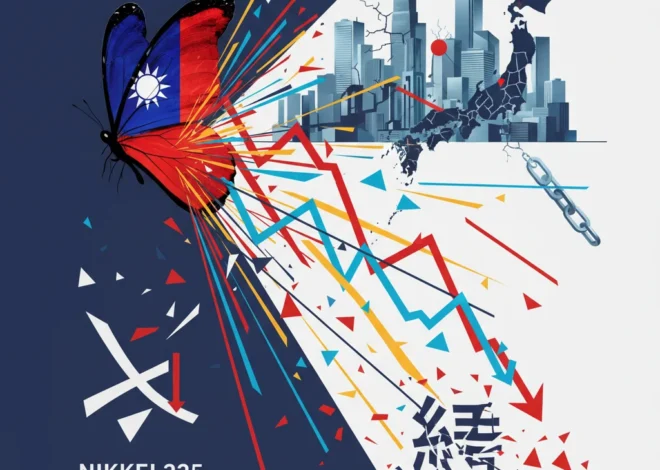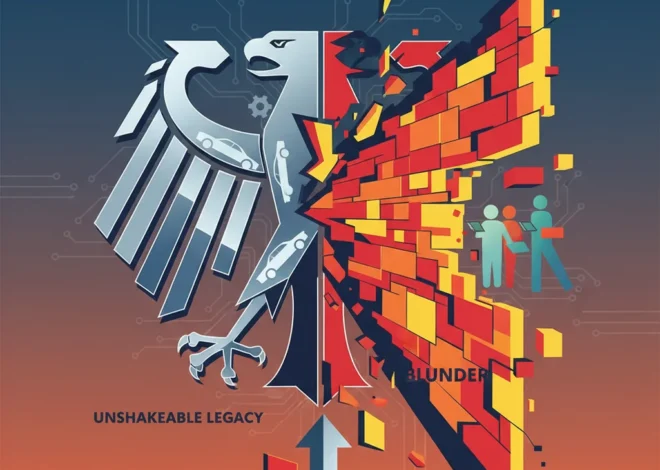
Calm or Chaos: Decoding the Binary Mindset of Modern Finance
In a brief but remarkably astute letter to the Financial Times, Subir Grewal, a co-founder at Washington Square Capital Management, made an observation that cuts to the heart of the modern financial world. He noted that New Yorkers—and by extension, the global financial ecosystem they represent—seem to exist in a state of psychological duality. They are, as he puts it, “either unflappable or hysterical” (source). There is no middle ground, no gentle slope of concern; there is only the serene plateau of business-as-usual or the terrifying cliff-edge of panic.
This observation is more than just a witty cultural commentary. It’s a critical diagnosis of the modern market’s operating system. In an era dominated by high-frequency trading, instant information, and a globalized economy, the psychological pendulum swings faster and with more force than ever before. Understanding this binary nature is no longer just an academic exercise in behavioral economics; it is a fundamental requirement for anyone involved in investing, finance, or business leadership.
This article will delve into this phenomenon. We will dissect the two poles of the financial psyche—the “unflappable” and the “hysterical”—and explore the psychological triggers and technological amplifiers that cause the market to lurch between them. We’ll examine how financial technology, from advanced analytics to blockchain, acts as a double-edged sword, and finally, we’ll discuss actionable strategies for navigating this volatile new reality.
The Anatomy of “Unflappable”: The Dangerous Comfort of Normalcy
The “unflappable” state is the default setting for the financial markets. It’s the long, often deceivingly calm, stretch of time between crises. During these periods, the stock market grinds upward, economic data is analyzed with clinical detachment, and risk is quantified in elegant models. This is the world of the rational actor, the efficient market hypothesis in action.
Several cognitive biases underpin this state of serene confidence:
- Normalcy Bias: This is the tendency to believe that the future will function in the same way recent past has. As weeks of market stability turn into months and then years, the collective belief solidifies that this stability is the new, permanent reality. As a study from the Journal of Behavioral Finance notes, investors often underestimate the likelihood of disasters, leading to inadequate preparation.
- Overconfidence: Success breeds confidence, and in finance, it can breed a dangerous sense of invincibility. When investment strategies are working and portfolios are growing, it’s easy for both individual and institutional investors to attribute success solely to their own skill rather than to favorable market conditions.
- Data Desensitization: In modern finance, professionals are inundated with a firehose of data—earnings reports, inflation figures, geopolitical updates. This constant stream can lead to a desensitization, where even genuinely concerning data points are dismissed as “noise” that doesn’t fit the prevailing bullish narrative.
This unflappable mindset is crucial for the day-to-day functioning of the economy. It allows for long-term capital allocation, fuels corporate investment, and provides the stability necessary for banking and trading operations. However, its greatest strength is also its greatest weakness: it systematically downplays the very risks that will eventually trigger the switch to hysteria.
A New Era for Wall Street: Analyzing the Economic Ripple Effects of NYC's Political Shake-Up
The Hysterical Switch: When the Dam of Calm Finally Breaks
The transition from unflappable to hysterical is rarely gradual. It is a sudden, violent phase shift, like water flash-freezing into ice. A single event—the collapse of a bank, a pandemic, a shocking inflation report—acts as the catalyst that shatters the illusion of perpetual stability. The very same market participants who were calmly analyzing spreadsheets a day earlier are now gripped by a collective panic.
This state is governed by a different, more primal set of psychological drivers:
- Loss Aversion: The principle, famously identified by Kahneman and Tversky, that the pain of losing is psychologically about twice as powerful as the pleasure of gaining. When the market turns, the fear of losing money overwhelms the rational desire to “buy low.”
- Herd Mentality: In times of uncertainty, humans look to the crowd for cues on how to act. When institutional funds start selling, and financial news channels flash red, the individual investor’s instinct is to follow the herd off the cliff. This behavior is a well-documented phenomenon that can turn a correction into a full-blown crash (source).
- The Narrative Collapse: The “hysterical” state is not just about falling prices; it’s about the collapse of the story that sustained the “unflappable” period. The narrative of “steady growth” is replaced by one of “imminent doom,” and every piece of data is now interpreted through this new, pessimistic lens.
This rapid shift has profound consequences for the economy. Credit markets freeze, consumer confidence plummets, and companies put hiring and investment plans on hold. The hysteria in the financial markets bleeds into the real economy with devastating speed.
The Great Amplifier: How Fintech Fuels the Extremes
If human psychology provides the fuel for these swings, then financial technology is the accelerant. Fintech has fundamentally re-architected the mechanics of banking, trading, and investing, intensifying both the calm and the chaos.
During the “unflappable” phase, fintech provides tools that reinforce confidence. Sophisticated analytics platforms, AI-driven risk models, and instant access to global data create a sense of control and understanding. This data-rich environment can make the current state of calm feel more justified and robust than ever before.
However, when the switch flips, these same technologies become weapons of wealth destruction:
- Algorithmic Trading: High-frequency trading (HFT) firms can execute millions of trades in seconds. When volatility spikes, automated programs designed to cut losses can trigger a cascade of selling far faster than human traders ever could.
- Social Media & “Meme Stocks”: Platforms like Reddit and Twitter can create and amplify narratives with unprecedented speed, leading to pockets of extreme hysteria disconnected from fundamental value (e.g., the GameStop saga).
- Information Overload: The 24/7 news cycle and instant notifications on trading apps mean investors are constantly bombarded with information during a crisis, making it nearly impossible to step back and make a rational, long-term decision.
Even disruptive technologies like blockchain are not immune. While praised for its transparency, the crypto market is perhaps the purest expression of the unflappable/hysterical dynamic, with periods of “HODL” conviction punctuated by brutal, panic-driven crashes.
The table below contrasts the characteristics of these two market states, highlighting the influence of technology.
| Feature | The “Unflappable” State | The “Hysterical” State |
|---|---|---|
| Core Mindset | Rational, data-driven, optimistic | Emotional, narrative-driven, fearful |
| Key Market Indicator | Low VIX (Volatility Index), steady growth | VIX spike, extreme price swings |
| Dominant Cognitive Bias | Normalcy Bias, Overconfidence | Loss Aversion, Herd Mentality |
| Role of Fintech | Risk modeling, data analysis, efficiency | Algorithmic selling, social media panic, information overload |
| Example Period | The market calm of 2017 | The COVID-19 market crash of March 2020 |
The EU's New Global Rulebook: A Bold Move for Sustainability or a Dangerous Overreach?
Finding the Middle Ground: Strategies for a Binary World
Given that this psychological duality is now hardwired into the modern stock market, how can investors and business leaders not just survive, but thrive? The key is not to predict the switch, but to build a strategy that is resilient to it.
For Investors:
- Embrace Behavioral Discipline: The most important tool is self-awareness. Understand your own susceptibility to fear and greed. Create a written investment plan during “unflappable” times and commit to sticking to it when hysteria strikes. As legendary investor Benjamin Graham advised, the investor’s chief problem—and even his worst enemy—is likely to be himself.
- Automate and Diversify: Use technology to your advantage. Set up automatic, recurring investments (dollar-cost averaging) to remove emotion from the buying process. A well-diversified portfolio across asset classes and geographies is the best defense against a panic concentrated in one area of the market.
- Focus on Time Horizon: Hysteria is almost always driven by short-term thinking. By focusing on a multi-year or multi-decade time horizon, you can view market crashes not as a catastrophe, but as a buying opportunity.
For Business and Finance Leaders:
- Fortify the Balance Sheet: The best time to prepare for a crisis is during the calm. For leaders in the banking and finance sectors, this means maintaining strong capital reserves and robust risk management frameworks that are stress-tested against “hysterical” scenarios.
- Communicate with Clarity: During a panic, silence from leadership is deafening. Clear, consistent, and honest communication with employees, customers, and stakeholders can act as a powerful antidote to fear.
- Invest in Resilient Systems: Ensure your company’s technology and operations can withstand extreme market volatility. This applies not only to financial firms but to any business whose supply chain or customer demand is sensitive to shocks in the wider economy.
Beyond the Ballot Box: How State Elections Shape Investment Strategy and the National Economy
Conclusion: The Unchanging Human Core of the Digital Market
Subir Grewal’s observation holds a mirror up to modern finance. We have built a technologically miraculous global system of capital allocation, a system capable of processing information and executing transactions at the speed of light. Yet, at its core, this complex machine is still driven by the old, primal human emotions of fear and greed.
The future of the economy and investing will be defined by the tension between our sophisticated technology and our unchanging psychology. The swings between unflappable and hysterical are not a bug in the system; they are a feature of its human-led design. Success will not come from eliminating this duality, but from understanding it, respecting its power, and building the discipline and resilience to navigate its inevitable, and often violent, oscillations.


